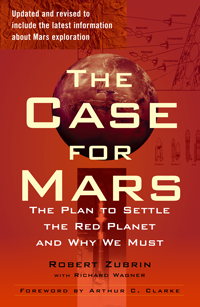
 We cover a lot of ground with our Book Spotlight, but it’s usually political ground. It’s nice to occasionally break out into something a little different. Since Tom’s Tidbits this month is about the entrenched bureaucracy of United Launch Alliance being challenged by the nimble and private SpaceX, we decided to bring you a very detailed look at another David-vs-Goliath-in-Space story. To do it, we’ll defrost one of our very own Book Spotlight reviewers for his take on one of his all-time favorite books…
We cover a lot of ground with our Book Spotlight, but it’s usually political ground. It’s nice to occasionally break out into something a little different. Since Tom’s Tidbits this month is about the entrenched bureaucracy of United Launch Alliance being challenged by the nimble and private SpaceX, we decided to bring you a very detailed look at another David-vs-Goliath-in-Space story. To do it, we’ll defrost one of our very own Book Spotlight reviewers for his take on one of his all-time favorite books…
 “The Case For Mars” by Robert Zubrin
“The Case For Mars” by Robert Zubrin
Review by Charles Letherwood. Click the book cover to go to the Powells.com site
In 1989, President George H.W. Bush wanted to revitalize a moribund space program for a new generation. In a soaring speech he called on humanity to return to space and reach for Mars. Politicians and engineers huddled together and came up with a number to do it… $500 billion. This was a staggering amount even for Congress, and support was non-existent. President Clinton officially removed human space exploration from the national agenda in his 1996 National Space Policy. Except for low-earth-orbit and robotic missions our space program was dead.
Dead, that is, until engineer Bob Zubrin decided to re-examine the Bush plan. Digging in, he found the plan revolved around a gigantic “Battlestar Galactica” ship built in a new orbital drydock and requiring exotic new technologies to function. Every aerospace company involved in the Bush estimate had deemed their services “critical” to a Mars mission, and the resulting pork and set-asides for every company and congressional district had inflated the price tag to the impossible. Even worse, the benefits of a Battlestar-Galactica-style mission would be limited to a surface stay of a few weeks with little time to do real science… a “flag and footprints” mission only.
So Zubrin changed one assumption that changed everything else… what if the astronauts didn’t take any fuel for a return trip, but instead made the return fuel on Mars itself? He put pencil to paper and found that the entire mission could be flown on 2 flights of existing Saturn V boosters. Making rocket fuel on Mars, seemingly new and exotic, was actually one of the simplest parts of the plan and could be done with gaslight-era technology. The new mission profile offered benefits never even contemplated in space flight, but most importantly it gave the astronauts almost a year on the surface with the resources to explore hundreds of miles from their landing site! Total cost? Only $50 billion; a tenth of the Bush number. And it could be even less if done by private companies rather than NASA.
Zubrin’s plan wasn’t the pie-in-the-sky dribblings of a crank. He presented his plan to NASA and, perhaps surprisingly, they not only saw the wisdom but acted on it. Zubrin’s “Mars Direct” mission architecture became NASA’s paradigm for eventual exploration of Mars. It’s the plan that audiences saw as the setting for the movie “The Martian”. In “The Case For Mars” Bob Zubrin details this mission for a non-specialized audience. He’s a clear and engaging writer, and makes what could be a dry technical analysis an inspirational and engaging read. From crew selection to landing on Mars to splashdown on Earth, he explains precisely how we can reach for the Red Planet. More importantly, he explains the opportunities that await all of humanity on Mars… if we can find the courage to go.
I was just four years old when human beings first landed on the Moon; too young to fully realize what I was seeing. Now I know I was just one of billions inspired by that awesome achievement, and just one of billions who believe our future in space isn’t over. The last human stood on the Moon 1972. It’s long past time to go back into space, but not back to the Moon… it’s time for Mars. This excellent book will tell you how we get there.










